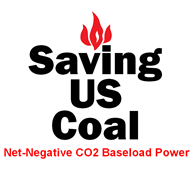
 











|
Signature Sponsor


By Frank Clemente and Fred Palmer; Coal is the Cornerstone LLC.
June 29, 2025 - First, let’s establish the stark reality of coal’s contribution to American Society during crises over the last decade:
2014 Polar Vortex, brought extreme cold across the US resulting in record winter peak electric demands. Coal provided the majority of electricity but, even more importantly, coal power increased 92% YOY to meet the load. Oil increased 12%, Wind 9% and Nuclear 7%. Natural gas (NG) generation decreased 6% YOY and Hydro declined 15%. Solar was irrelevant. NG was diverted to space heating needs and prices in the Northeast exceeded $100/ MMBtu. New England Utilities resorted to burning jet fuel.
2019 “Cold Event” a severe cold wave caused by an Arctic Polar Vortex hit the East and Midwest leading to fatalities. In the PJM region (65 million people) coal power led all fuels at 37% of electricity. All renewables combined contributed only 7% of electricity. In the MISO region (45 million people), coal provided 50 % of electricity and operated at 73 % of installed capacity.
2021- Winter Storm Uri impacted much of the US. Extreme cold forced the MISO grid, which stretches across 15 states and Manitoba, to make emergency load reduction. Coal-based generation surged 36 percent and met almost 50% of demand. Solar power was virtually non-existent, and MISO reported that “output from wind generation was low throughout the duration of the event”. NG prices increased from less than $3 per MMBTU to as much as $700.
2024- Winter storm, multiple cold weather fronts moved across the country, setting low-temperature records. Energy Ventures Analysis (EVA) noted that across the three storms, coal-fired power plants showed the most significant increase in utilization rates: “Wind generation faced challenges… while solar generation was entirely or almost entirely absent.” Further, EVA concluded: “Higher shares of solar facilities and fewer dispatchable resources likely would have resulted in widespread power outages “.
2025 Polar Vortex –Demand across the East, Midwest, and South reached 537 GW in January – the highest ever recorded and approximately 150 GW above average. Per EVA, coal-fired generation “played a vital role” as capacity factors reached 70%. At peak demand, wind and solar were only able to generate 3% and .0.2% of the electricity to meet the load. NG prices spiked to $30/MMBtu compared to coal’s $2.50. EVA estimated coal saved customers up to $1.4 billion.
Now, put these data in the context of the US Energy Information Administration’s 2025 Annual Energy Outlook published just this past April. Despite the experiences presented above, the EIA “Reference Case” projects that within 10 years coal will be largely removed from the American energy landscape. Coal capacity will decline from 170 GW to only 3 GW—a decline of 98%. Meanwhile, coal will produce less than 1% of the Nation’s electricity in 2035. Also, coal production will decline from 500 million tons to 167 million and only 27 million tons will be used by power plants. In essence, the coal franchise will basically disappear in the United States.
Solar, which has already demonstrated its inability to provide electricity in a cold crisis, is projected by the EIA to increase capacity from 127 GW to 476 GW. Solar generation is forecasted to grow from 200 billion kWh to over 1,000 billion kWh--- a 400% increase. Wind, whose track record in winter is only slightly better than solar, is projected to grow capacity from 153 GW to 350 GW in just 10 years. Wind generation is forecasted to increase from 447 billion kWh to over 1,150 billion. According to the EIA, the US will become ever more dependent on intermittent and non-dispatchable power as both nuclear and NG based electricity are projected to decline while coal is eliminated. Meanwhile, China, India and others are building baseload units (especially coal) to meet the reliability requirements of the next generation of AI and its associated Data Centers. These international planners of AI technology are well aware of the warning by Potomac Economic Research Group: “Increased intermittent output and its associated fluctuations … has resulted in more frequent emergency events.” Some in the industry may scoff at the EIA projections because President Trump has taken several first steps to support coal. But keep in mind the President’s term ends in 43 months. Will it be back to Business as Usual?
Don’t forget, coal generating capacity has declined from almost 300 GW to 170 GW in the past decade. It is not much of a reach to see how 170 GW can turn into 3 GW in another 10 years. The “War Against Coal” is pervasive, relentless and heavily funded. Multi-Billionaire Michael Bloomberg has committed $500 million to eliminate coal and his support for the Sierra Club’s “Beyond Coal” Campaign is clear: “We want to close all US coal plants”. As many as 200 lawyers and organizers have been hired to litigate and work against coal. They attend hearings, lobby regulators, give speeches, talk to classrooms, write editorials and have been markedly successful in demonizing coal. And, if EIA is correct, the worst is yet to come.
-----------------------------------------------------------------------------------------------------------------------------------------------------------------------------------------------------------
Comment- Coal’s role as a Cornerstone Fuel goes far beyond winter crises but is a 24/7 contributor to reliable and affordable electricity all year round. And, as far as summer heat goes, this paper is being written in a heatwave (June 26), where, even after the closure of hundreds of power plants, coal-based electricity still underpins key US Federal Power Markets: MISO-32%. PJM-19%, SPP- 33% – Just these three Markets stretch across 43 states, Manitoba and the District of Columbia.
-----------------------------------------------------------------------------------------------------------------------------------------------------------------------------------------------------------
Note: Coal is the Cornerstone seeks to give a voice to supporters of coal in its many dimensions and contributions. But we need help and ask like-minded individuals and companies supporting coal to make a financial contribution to the effort. Visit us and donate at http://www.
-----------------------------------------------------------------------------------------------------------------------------------------------------------------------------------------------------------
Frank Clemente PhD Is Professor Emeritus at Penn State University. He specializes in research on the socioeconomic impact of energy policy and is the author of The Global Value of Coal, published by the International Energy Agency (2012). Professor Clemente has extensive experience in speaking, writing and presenting data on the value of coal to the United States and the world. All opinions expressed here are presented independently from the University.
Fred Palmer Esq. served as CEO of Western Fuels before he joined Peabody Energy as Senior Vice President for Government Affairs. Palmer was Chair of the World Coal Association Board and a member of the National Coal Council. He received the American Institute of Mining, Metallurgical and Petroleum Engineers Award for “Distinguished Achievement in Coal Technology”. He also received a Statement of Appreciation from the National Coal Council in 2015 with a plaque for “Guidance since 1990”.
|
 










|